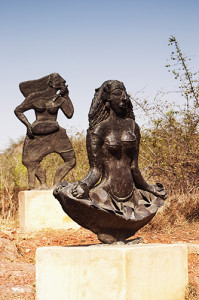As I entered a familiar room recently, I realized the multi-sensory impact of the music that was playing in the background. The room not only felt different than before, but there was a definite quality in the room mingling among the others that called to mind the sights, smells, and even tastes of past experiences that truly moved me. The sound was greatly enhanced by this awareness.

The world shapes all of us through events in our personal experiences; the extent to which we are able to expand our awareness and pay attention to all the ways of sensing things can significantly influence our understanding of what’s going on around us. Artists use their full sensory capabilities, whether visual artists, writers, musicians, actors, or dancers. Beethoven wrote some of his most profound music in deafness, his remaining senses expanded and contributing to his hearing.
All our knowledge begins with the senses, proceeds then to the understanding, and ends with reason.
~ Immanuel Kant
In the mid-19th century, composer Richard Wagner searched for a way to synthesize the poetic, visual, musical, and dramatic aspects of his compositions in an effort to engage all the senses. He felt that the various art forms had become too disparate. He strived, particularly in his later operas, to engage and awaken all senses so the audience could be led through a more profound appreciation and experience. He even wrote a manifesto, The Artwork of the Future, which detailed his vision for the arts. While his philosophy was focused on how the arts should be integrated in a single work, this concept of experiencing all the senses can be expanded well beyond his initial vision. Artists of all kinds now incorporate this multi-sensory intelligence into their work every day.
Painting from nature is not copying the object; it is realizing one’s sensations.
~ Paul Cezanne
![Madame Cézanne in a Red Dress by Paul Cézanne [Public domain], via Wikimedia Commons. Cézanne wanted to see and sense the objects he was painting, rather than just think about them. Madame Cézanne in a Red Dress by Paul Cézanne [Public domain], via Wikimedia Commons. Cézanne wanted to see and sense the objects he was painting, rather than just think about them.](https://artsawareness.com/wp-content/uploads/2015/01/Madame_Cézanneweb-229x300.jpg)
While artists spend their lifetimes developing this sensory awareness as a part of their artistic growth and development, we can all do the same by paying closer attention to things around us in our everyday environments. Our senses seem to operate separately, as distinct ways of perceiving the world, but they actually work together closely to help our minds make sense of everything around us. Everyone can learn to become more aware of this collaboration between our senses and our intellect and use the information to inform all of our experiences.
Many artists followed and expanded upon Wagner’s inspiration, such as Auguste Rodin, Frank Lloyd Wright, Wassily Kandinsky, Gustav Mahler, John Cage, and Merce Cunningham. They created great works as they too searched for ways to reach across disciplines, creating a more expansive sensory experience to fully express their ideas. In today’s world there is an even a greater emphasis on the heightened awareness of personal experience as the digital world dramatically expands the synthesis of sensory experience.
Let’s try to be more deliberate about how we are experiencing our work and personal lives. Focus for a moment, quiet your mind, and pay attention to all of your senses, even one at a time if necessary. The next time you attend a concert, walk through a room with music in the background, or play music in your own home, listen with all your senses. Make a mental note of how that awareness impacts your experience, how you interact with others, and how the combined sensory experience might be different and more informative than the focus on just one.
— Pat
Sign-up for the Arts Awareness eNewsletter and receive a free gift “Three Lessons to Begin to Make Artistic Principles Work for You in Fascinating Ways.” Like Arts Awareness on facebook.
